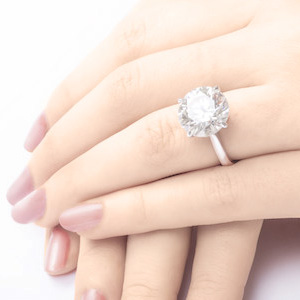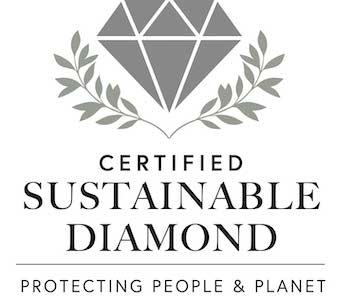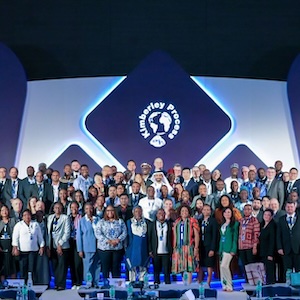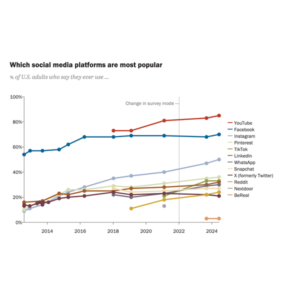
For years, lab-grown diamond sellers habitually dubbed their products sustainable and eco-friendly. However, in 2019, the Federal Trade Commission (FTC) sent letters to several companies warning them not to use those terms.
The issue wasn’t just that the companies provided almost no information about the eco-impact of their processes—though that probably didn’t help. It was the language that they used, what the FTC called “general environmental benefit claims,” which are forbidden under its Green Guides.
“It is rare that a product can have an environmental benefit in all the ways that consumers might take away from a general claim,” said FTC attorney Robert Frisby.
In other words, the term sustainable means different things to different people. Even the FTC admitted the term has no true definition, so using it doesn’t help a consumer make an informed choice. In many cases, using those terms for lab-grown diamonds is arguably misleading, since some of these supposedly eco-friendly growers use coal power, which worsens climate change.
Now, SCS Standards, a division of SCS Global Services—which has conducted audits for the Responsible Jewelry Council (RJC) and Brilliant Earth—has developed a sustainability certification for the diamond industry. Anyone interested in understanding the company’s definition of sustainability can refer to its publicly posted 128-page standard.
That wording still may not fly with the FTC. Stanley Mathuram, executive vice president of SCS, which has issued sustainability seals for other products—like palm oil and seafood—says the company hasn’t run its verbiage past the FTC, but the agency is welcome to weigh in. That said, it’s quite likely that diamonds rated “certified sustainable” by an outside body will receive a less skeptical reception from regulators—and consumers—than a company declaring itself sustainable just because it sounds good.
SCS’ sustainable diamond standard has been nearly two years in the making. In 2019, the company was first enlisted to develop a certification process for lab-grown diamonds. Eventually, it broadened its efforts to include all types of diamonds and gemstones.
Today, the SCS certification can be attained by diamond miners, colored stone miners, and sellers of recycled diamonds. SCS also hopes to develop a standard for artisanal mining and one for pearls. Like all such standards, it will be refined and updated.
The standard includes two tiers—“certified responsibly produced” and “certified sustainable,” with the latter being the higher of the two—and rates companies on 15 different categories.
Perhaps the most important category is climate neutrality, which, Mathuram asserts, goes beyond carbon neutrality: It mandates net-zero carbon emissions, and aims to do the same with the other harmful chemicals used in the growing process, such as methane, which he calls a “strong climate pollutant.”
As with carbon neutrality—which has been attained by one lab-grown diamond company, Diamond Foundry—climate neutrality involves both lessening pollutants and buying offsets. Offsets let companies claim a net-zero footprint by supporting environmentally worthy projects or purchasing carbon or solar credits. It’s an accepted, if sometimes controversial, practice.
The other 14 categories cover everything from water use to smog creation. Some allow offsets, and some don’t. The certified companies don’t have to be impact-neutral in every category right away. A certified sustainable diamond must be impact-neutral in at least 8 of the standard’s 15 categories within three years of certification, and 12 of the 15 within six years. A responsibly produced stone doesn’t have to be impact-neutral in any of the 15 categories except for climate neutrality.
There are also standards for workers’ rights, human rights, business integrity, knowing your counterparty, occupational health and safety, and legal compliance (i.e., no more playing games with the FTC).
The sustainable standard’s crafters kept in mind that different diamond production methods have different issues (though they all have issues).
With lab-created diamonds, the biggest problem is heavy energy use; synthesizing diamonds requires temperatures as hot as the sun. While it’s good to be wary of blanket statements, SCS has generally found that growing gems requires more energy than mining them, and diamond mining is not as environmentally harmful as some portray it to be.
“Mining diamonds is probably one of the cleanest forms of mining,” Mathuram says. “They’re digging rock, so they don’t use any chemicals, like with gold mining. When you get into emissions, they are going to do very well.”
That doesn’t mean that diamond mining can’t have serious and damaging environmental effects—sometimes spillover from the operation hurts nearby wildlife or rivers. That wouldn’t be allowed under the SCS standard.
“There will always be land-use disturbances, but you have to mitigate those impacts,” he says. “But when something is really harmful, you can’t offset that.”
So far, however, most of the companies that have shown interest have been lab-grown diamond sellers, though it’s possible some gem miners and maybe even pearl farmers will enroll in the program. Diamond miners have so far been reluctant, which Mathuram doesn’t understand, given how many are already involved in certification programs, like the RJC and the ultrastrict Initiative for Responsible Mining Assurance.
“For the life of me, I don’t get it,” he says. “I can only think it’s related to their ongoing dispute with lab-grown.”

The first gem company—of any type—to achieve sustainability certification (the highest level) is WD Lab Grown Diamonds, which has been working on meeting the standards for a year.
“[Certification is] not for the faint of heart,” warns Sue Rechner, WD’s CEO. “Most businesses don’t run according to standards of environmental and social impact. We had a lot of things in place, but also there were a lot of things we didn’t know.”
Eventually, the company enlisted an environmental consultant.
“What I recognized right away is that we didn’t have the knowledge to do this,” Rechner says. “I’ve been involved in sustainability in my past, and advocated and led a lot of those efforts. But this was a really heavy lift.”
In the end, the company tightened up its anti-corruption and anti-money-laundering rules, and wrote a new code of ethics for all its employees.
“It’s a pretty exhaustive document that is brand-new to the organization, and it was a core fundamental milestone in the process,” says WD chief marketing officer Brittany Lewis, who eventually took over the process. “So now, each individual employee has a responsibility of driving toward environmental responsibility and human rights and fair treatment of their fellow employees.”
Now that SCS has reviewed its systems, WD can call all its newly produced diamonds certified sustainable and certified climate neutral. This will be part of the company’s branding as it changes its name to Latitude.
To receive this thumbs-up, WD needed a review of not just its processes, but those of its cutters, and a way to track its diamonds through the pipeline.
“The standards committee included representatives from industrial-scale mining, small-scale mining, recycled diamonds, and lab-created producers,” Rechner says. “We found out there were commonalities along the chain of custody where we saw opportunities to not just provide for traceability and transparency but to drive better practices across the pipeline.”
WD worked with an Australian company that specializes in laser ablation to track its diamonds from its factory to the store. This technique has been used with some success in natural diamonds.
“We’re working closely with that vendor to build up a database,” says Lewis, “so they have samples and material from us in order to basically define what our fingerprint looks like. And then that assurance is built through a calendarized secret shopping process, so any of our stones that are out there in the market that carry these claims would be eligible to be tested.”
And while laser testing requires some damage to the diamond, “it’s not as destructive as we thought,” Lewis says.
WD is offsetting not just its current production, but its historical output, so now its entire inventory can bear the certified climate neutral seal (though, depending on when they were produced, not necessarily the sustainable one). And while WD plans to tout its new certification in its marketing, it probably won’t lay out all it took to get there.
“The standard does not require us to provide hard data about our total size of operation,” says Lewis. “[We have] confidentiality and IP concerns there. But we are working toward sharing a per-carat summation that will help to kind of contextualize in the consumer’s mind our total climate footprint.”
This certification will only apply to diamonds produced by WD (and any other company that achieves the certification). But a ring with a WD diamond can’t necessarily be called certified sustainable, unless there’s a similar assurance about its mounting and side stones.
Of course, there’s a question of how potent this positioning will be, since, despite the FTC warning, some in the lab-grown industry continue to call themselves “eco-friendly” without any backup, just like they have done for years.
“I’m sure people will continue to greenwash,” says Rechner. “We have some wonderful competitors out there, but there’s also some unsavory characters, and they’re going to continue to peddle their untruths. I believe that consumers see inauthentic behavior miles away, and if you try to run on a platform that isn’t real, some people might buy into it, but most won’t.
“Information is readily available today, and people will see that there’s a standard out there. There was never a standard before. So we can counter that with facts and a standard.”
While WD likely won’t be the only company, lab-grown or otherwise, to achieve this certification, Rechner considers achieving this certification an important moment for not just her company but the entire diamond industry.
“This industry has traditionally been supply-driven,” she says. “It’s not really been consumer-centric. So this helps us move into a place where we are now in the consideration set for more consumers.
“Our hope is that the industry will fall in line and start behaving in the same way,” she says, “and we can march toward better standards and expectations of ourselves and of each other.”
(Top photo courtesy of WD Lab Grown Diamonds)
Follow JCK on Instagram: @jckmagazineFollow JCK on Twitter: @jckmagazine
Follow JCK on Facebook: @jckmagazine







